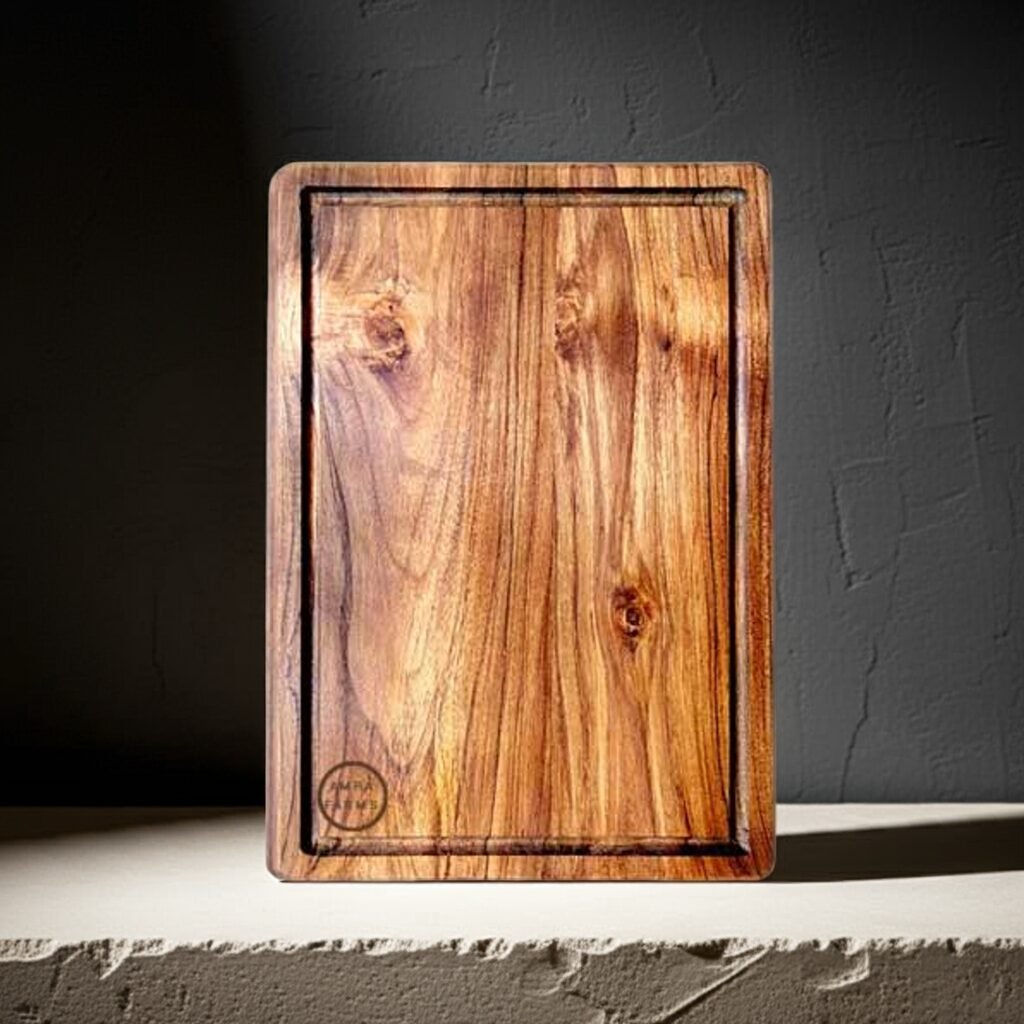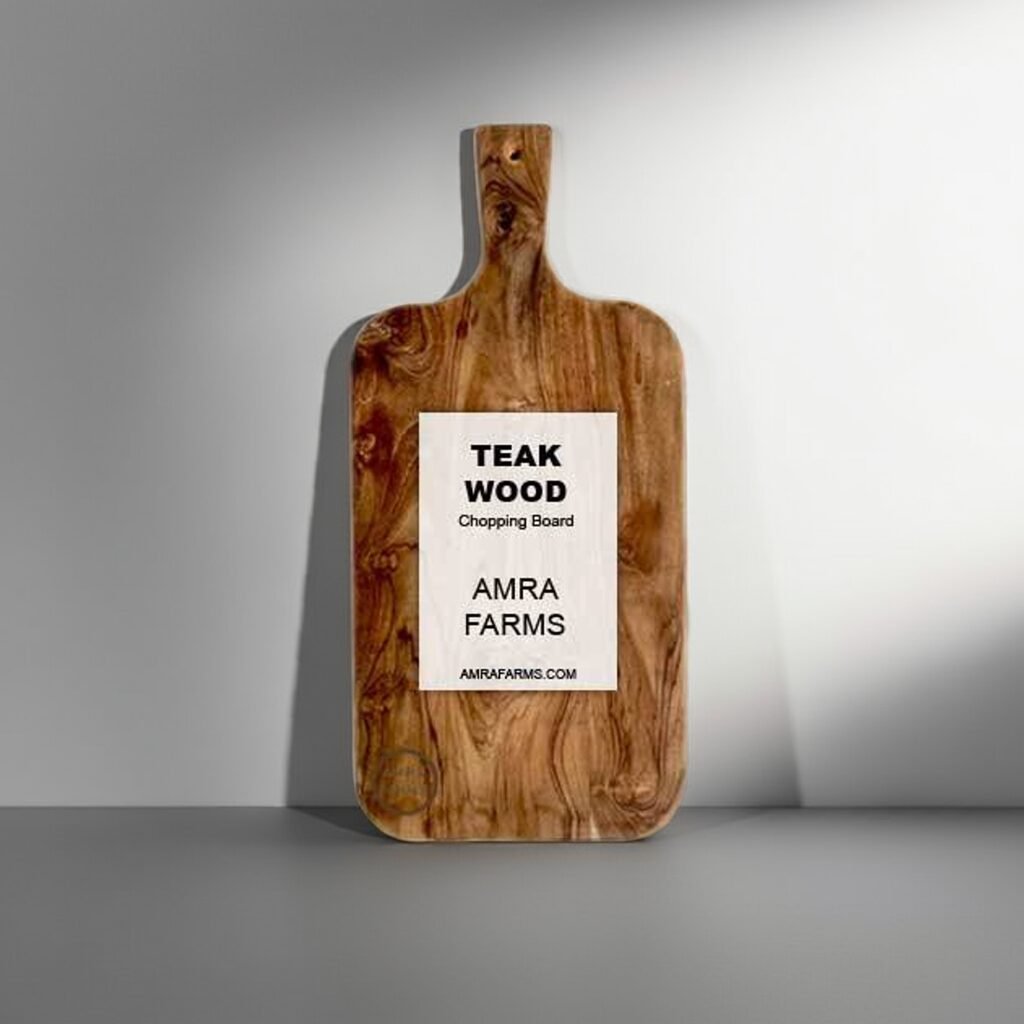Your cart is currently empty!
Best Wooden Cutting Boards for Knives
A high-quality knife is an investment, but its longevity depends on proper care, and your cutting board plays a major role in it. Hard surfaces like plastic, bamboo, glass, and steel are too rigid for sensitive knives and can cause premature dulling of knife edges. On the other hand, a soft surface like softwood would be bad for the board itself and food safety.






Wooden boards, specifically hardwood boards, can absorb impact with minimal wear and tear, helping you retain your knife’s sharpness for longer. A dull knife is inconvenient and requires you to apply more pressure while cutting, increasing the risk of accidents. A sharp knife allows for faster chopping and more efficient results.
Advantages of High-Quality Wooden Cutting Boards Over Plastic and Glass
Wooden cutting boards are not just durable, hygienic, and beautiful, but they also have the advantage of keeping knives sharper for longer. Unlike plastic, glass, or steel boards, which are far from aesthetically pleasing, wooden boards are better looking and last long enough to make them a valuable addition to your kitchen.
Some of the key features that make wooden boards superior to glass, steel, and plastic boards include:
- Knife Friendliness: Wooden boards are easier on knives, keeping them sharper for longer and preventing rapid dulling of the edges.
- Naturally Antibacterial: Wooden boards, especially those made from the right wood like teak, mango, or neem, have natural antibacterial properties due to their rich oil content.
- Durability and Longevity: When well cared for, wooden boards can last decades. Teak wood boards are often known to last 20–30 years with proper care and annual refurbishing. Mango wood and neem can easily last 5–6 years while retaining their beauty throughout the years.
- Self-Healing Properties: Among all cutting board materials, wooden boards are the only ones that can heal themselves from cuts naturally. Even bamboo boards do not recover from cuts as easily and efficiently as wooden boards.
- Aesthetic Appeal: Wooden cutting boards, no matter their color or type, add elegance and warmth to your kitchen and home. You can confidently use them as a serving board for cheese, bread, and charcuterie.
- Eco-Friendly and Sustainable: Most wooden products are sustainable. Mango wood, teak, and acacia are all renewable resources that are ethically sourced, making them more eco-friendly compared to plastic, glass, and steel.
Why Choose a Wooden Cutting Board?
Wooden chopping boards offer many benefits—they are durable, antibacterial, and more. While steel and glass chopping boards are also antibacterial and more durable than wood, what makes wooden chopping boards stand out?
Here are four distinct features that make wooden chopping boards the first choice for professional chefs:
- Gentle on Knives: A good wooden chopping board, especially one constructed with an edge grain design, is easier on knives than plastic, steel, or glass boards. For those who use expensive knives, this feature alone is more important than many others.
- Naturally Antibacterial: Woods like teak, neem, and mango are highly antibacterial. Their natural oil content, combined with their self-healing properties, reduces the risk of contamination in food.
- Aesthetic Appeal: Wooden chopping boards are naturally more desirable than most other boards. While plastic, steel, and glass boards have their own appeal and followers, wooden chopping boards—no matter the type of wood—add a distinct charm to kitchens and homes.
- Self-Healing Surface: Wood is naturally self-healing. With an end grain design, the board can endure years of cuts and scratches yet look like new due to its self-healing features. Wooden boards also trap bacteria effectively, reducing contamination risks.
2. Types of Wooden Cutting Boards
The construction of a cutting board plays a crucial part in the functionality of a wooden chopping board. Three most common constructions include end grain, edge grain, and face grain.
End Grain Cutting Boards – Best for Knives
End grain cutting boards are made by arranging small blocks with the vertical end of the wood facing up. While the design creates a checkered board-style pattern, the grains are hidden with the ends of the wood facing up. This makes it gentle on knives, self-healing, and very durable. Mostly used by professional chefs and serious home cooks, end grain chopping boards take more time to create and are often priced 3–4 times more than edge grain boards of the same size and material.
Edge Grain Cutting Boards – Best for Everyday Use
The edge grain cutting boards are the most common cutting boards. They are durable, affordable, and easy on the knives but slightly harder compared to end grain boards. The construction of the board involves aligning long wooden planks side by side, creating a straight grain pattern. Being very affordable, edge grain boards are the ones that are commonly available in stores.
Face Grain Cutting Boards
Face grain boards are made from wide flat planks of wood displaying the natural grain patterns. They are budget-friendly boards and have a smooth decorative surface. They are prone to knife marks and are known to be less durable. They make a perfect serving board or charcuterie board to serve cheese, meat, bread, and presentations.
3. Best Woods for Cutting Boards
The wood you use impacts the quality of your chopping board. While some woods are easier to obtain, cheap, and readily available, some are expensive. Each wood has its own set of features, and their uses are determined by their efficiency.
a. Acacia – Affordable, durable, slightly harder on knives
Acacia is a hardwood that is highly durable and budget-friendly. Being a tree cultivated for its wood, it is a sustainable source and grows in dry areas. The quality of the wood is relatively hard on knives. It is more rigid than walnut or mango but softer than plastic and glass.
b. Teak – Water-resistant, long-lasting, rich golden-brown color
While a teak wood chopping board is more expensive, it is naturally resistant to water and durable. It is softer on knives compared to acacia. Though teak wood is known to be harder than acacia, its effect on knives is soft. Depending on the composition of silica in the wood, it can sometimes be hard on knives. It is expensive and considered premium. The rich brown color adds an elegant touch to your kitchen.
c. Mango – Sustainable, lightweight, soft on knives
Mango wood is sustainable, easier to find, and extremely soft on knives. The mango wood chopping board is the best when you require maintaining your knife’s sharpness. Better than teak and acacia, mango wood is known to be easy to handle, lightweight, and eco-friendly. Mango wood is the preferred cutting boards for chopping vegetables.
5. How to Care for Your Wooden Cutting Board
All wooden cutting boards require proper care and maintenance. Be sure to only use mild soap and warm water to clean your boards. Treat your boards with coconut oil, mineral oil, or beeswax to ensure that the oil content of the board is balanced. Remove stains with natural techniques like a salt and lemon scrub. Do not use harsh chemicals to clean your board. Oiling your board regularly ensures it lasts long without cracking and drying out. Do not leave it in direct sunlight or in water for too long.
If you stick to the basic care guides, your cutting boards will last for years, maintaining their beauty and aging gracefully.
Tip: Use both sides of the cutting board—one side for meat and fish and the other for vegetables and bread. This way, you will avoid cross-contamination and won’t have to invest in two different boards.
Categories
Products
- Buy Wooden Vegetable Cutting Boards Online
- Wooden Kitchen Accessories & Tools
- Buy Butcher Block & Meat Cutting Boards Online
- Buy Premium Wooden Chopping Boards Online
- Buy The Best Teak Wood Cutting Boards Online In India
- Buy Wooden Cutting Boards With Handle For Kitchen
- Mango Wood Chopping Boards
- Tamarind Wood Chopping Boards
- Wooden Platter Boards , Pizza Platters & Charcuterie Boards
Recent Posts
- Why is tamarind wood Preferred for cutting meat and vegetables in India?
- Wooden chopping boards, the construction and trends that affect your purchase
- Market and usage statistics on wooden chopping boards – Fascinating Market insights and trends you can’t ignore
- Chopping Boards for Traditional Indian Pickling – Avoiding Contamination with Tamarind & Teak Boards
- Are Imported Wooden Chopping Boards Overrated? Why Indian Woods Perform Better in Local Conditions
